San Francisco Officer-Involved Shooting on Highway 101: Incident Overview and Community Response
Rapid Police Action on Highway 101 Amid Armed Suspect Confrontation
On Tuesday evening, San Francisco law enforcement officers responded promptly to reports of a man wielding a bladed weapon near the entrance of Highway 101. The encounter escalated quickly during peak traffic hours, compelling officers to employ measured force to neutralize the threat. An officer discharged their firearm after attempts to de-escalate the situation verbally were unsuccessful. The incident caused significant traffic disruptions and drew a large emergency response, including paramedics who transported the critically injured suspect to a nearby hospital.
Important facts about the event include:
- The suspect’s identity has not been released pending ongoing investigations.
- Eyewitnesses confirmed hearing officers issue clear verbal commands before the shooting.
- All officers involved have been placed on administrative leave as part of standard procedure.
- Traffic congestion persisted for nearly two hours while authorities secured and processed the scene.
| Incident Detail | Information |
|---|---|
| Location | Highway 101, near Exit 430 |
| Time | Around 5:15 PM |
| Units Deployed | Three patrol cars and one K-9 unit |
| Weapon Involved | Edged weapon (specifics withheld) |
Understanding Use-of-Force Protocols and Officer-Involved Shooting Procedures
The San Francisco Police Department has affirmed adherence to established use-of-force guidelines during the incident. Officers initially employed multiple verbal de-escalation strategies, but when these failed to mitigate the threat posed by the armed individual, the use of a firearm was deemed necessary to protect public safety.
Officer-involved shootings (OIS) within the SFPD are subject to comprehensive scrutiny to ensure compliance with departmental policies. The review process includes:
- Securing the scene immediately and providing medical assistance
- Gathering all relevant evidence, including body camera footage
- Conducting interviews with involved officers and witnesses
- Oversight by the independent Use of Force Review Board
| Review Phase | Objective | Timeline |
|---|---|---|
| Immediate Response | Control the scene and assess threats | Within minutes |
| Evidence Documentation | Collect and preserve all pertinent data | Within 24 hours |
| Comprehensive Review | Evaluate adherence to policies and procedures | Up to 30 days |
Community Perspectives and Legal Analysis on Policing Practices
Local community advocates have voiced concerns regarding the delicate balance between maintaining public safety and ensuring transparent, accountable policing. In light of the Highway 101 shooting, neighborhood groups stress the critical need for enhanced officer training in de-escalation and mental health crisis intervention. Many propose adopting alternative response frameworks that emphasize negotiation and mediation, particularly when dealing with suspects armed with non-firearm weapons.
Legal professionals highlight the complexity of evaluating use-of-force incidents, emphasizing the necessity to weigh the immediacy of the threat against constitutional protections. The following criteria are commonly examined during legal reviews of such cases:
| Assessment Factor | Explanation |
|---|---|
| Threat Immediacy | Evaluates danger to officers and civilians |
| Force Proportionality | Ensures response matches threat severity |
| De-escalation Efforts | Documents attempts to use non-lethal options |
| Policy Adherence | Confirms compliance with departmental guidelines |
- Community Impact: Calls for greater transparency in investigative processes.
- Training Enhancements: Advocacy for expanded conflict resolution and crisis intervention programs.
- Legal Oversight: Support for independent review boards to ensure impartiality.
Advancing Police Training and Crisis Management Strategies
To minimize incidents involving the use of lethal force, law enforcement agencies are encouraged to invest in advanced crisis intervention training. Officers should be equipped to identify signs of mental health emergencies and emotional distress, enabling tailored responses that prioritize safety and de-escalation. Incorporating realistic simulations, including scenarios with edged weapons, can enhance officers’ preparedness to manage high-pressure situations without resorting to firearms.
Essential elements for improved training programs include:
- Ongoing refresher courses on crisis psychology and behavioral assessment
- Partnerships with mental health experts to design authentic training scenarios
- Use of body-worn cameras to evaluate engagement tactics and promote accountability
- Workshops focused on stress management and critical decision-making under pressure
| Training Focus | Expected Outcome |
|---|---|
| Scenario-Based Drills | Improves accuracy and confidence in real incidents |
| Verbal De-escalation Techniques | Lowers frequency of forceful interventions |
| Mental Health Awareness | Enhances recognition and management of crises |
| Post-Incident Reviews | Encourages continuous improvement and transparency |
Conclusion: Ongoing Investigation and Commitment to Accountability
The San Francisco Police Department continues to investigate the circumstances surrounding the Highway 101 shooting. Authorities have pledged full transparency and encourage witnesses or anyone with pertinent information to come forward. This case highlights the complex challenges law enforcement faces when confronting potentially dangerous individuals and underscores the necessity of thorough, impartial reviews to maintain public trust and safety. Updates will be provided as new information emerges.




